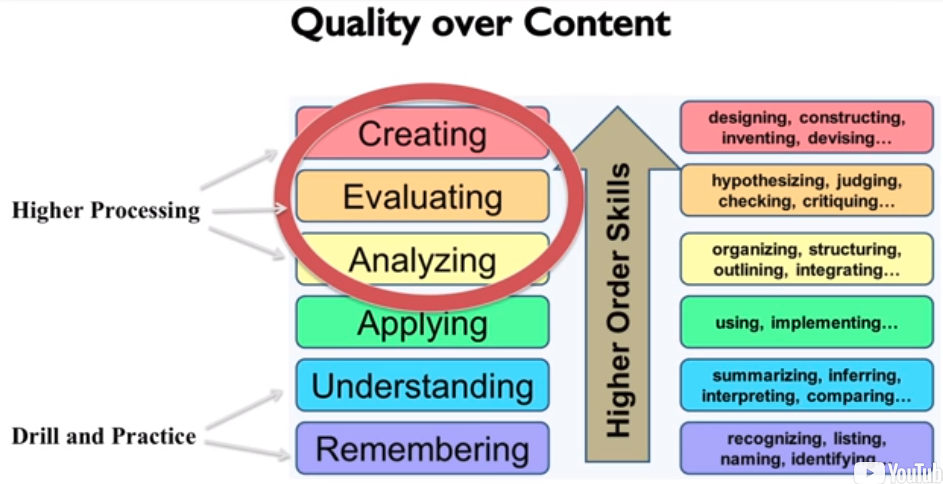Clinical Assistant Professor, Liz Kolb, School of Education, and University of Michigan
In this section of the course eBook we are going to look at using technology in K-12 schools. The main takeaway for this chapter is “Learning First, Tech Second”.
Much of the content is derived from a massive open online course (MOOC), LEADED501x Leading Ambitious Teaching and Learning from the University of Michigan, School of Education, Ann Arbor Michigan.
youtu.be/NfalVfdT640
Technology integration is driven by good teaching practices and not fancy tools.
Added Value
does not say we should be isolating students. They should not be using a bunch of what we call drill and practice software which is where they do a lot of multiple choice type questions. Instead, we need to do what we do in mathematics. We need to ask students to inquire, to analyze, to synthesize, to hypothesize.
adding value to the learning.
Key Takeaways
Research on Effective Tech Use in Learning
- Elicit higher-order thinking around content over consumption of content. (Wenglinsky, 2006)
- Quality over quantity (Wenglinsky, 2006)
- Avoid “drill and practice” in isolation. (Wenglinsky, 1998)
- “Value-added” element to the learning (Means et al. 2009)
we need to avoid drill and practice software despite the hundreds of thousands of pieces of educational software that are drill and practice. Because those rarely have learning gains, and often, they are negative learning gains. In addition to that, it’s quality over quantity.
Key Takeaways
Research on Effective Tech Use in Learning
- Focus on learning goals (Linnenbrink & Printrich, 2003)
- Time-on-task active engagement (Wartella, 2015)
- Co-use or joint media engagement (Darling-Hammond, et al, Hirsh-Pasek et al. 2015, Guernsey, 2012)
- Connect learning to authentic experiences (Vaala et al., 2015, Guernsey, 2012), Wartella, 2015)
Technology
should bridge school experience with everyday life and the world around the student.
Modeling and Guided Practice
I do, we do, you do, format. When they’re doing that, and not just modeling how to navigate the software, but in particular, how to think as they’re navigating the software.
What do we mean by eliciting higher-order thinking skills?
Key Takeaways
We know that technology should engage learners.
We know that technology should enhance learning. It should add value to it.
We know that technology should be extending learning beyond the classroom in unique ways.
Technology Should (Triple E)
| Engage Learning | Enhance Learning | Extend Learning |
- Time-on-task learning
- Focus on learning goals
- Co-use and Co-Engagement
- Social
- Less distractions
| - Value added to learning
- Scaffolds and supports
- Could not do with Traditional Tools
- Personalized
- Differentiation of learning
| - Bridge School Learning and Everyday Lives
- Help Students Make Sense of the World TODAY
- Connecting Existing Knowledge with new Knowledge
|
What is Engaged Learning with Technology Tools?
time-on-task, we know that technology should be helping students focus on the learning goals. It should allow opportunities for students to learn with less distractions.
Reflections
- Do you notice co-use or joint engagement in different ways? Either students working collaboratively with devices or they’re choosing apps and software that is collaborative for students, so they can work on it together?
- How are the teachers monitoring and checking in with the students?
- Are they modeling how to navigate the tool, and comprehend the content with the tool?
What is Enhanced Learning with Technology Tools?
youtu.be/5pLhfoybeUI
Technology should add value to the learning goals
First, we want to look for this idea that there’s a value added. That somehow, students are able to develop a more sophisticated understanding of the content learning goals because of something that’s happening with the technology.
Technology includes supports and scaffolds to help make learning more attainable (accessible)
Technology can often bring in scaffolds, or supports, for the students, whether it’s feedback, whether it’s a way to differentiate instruction through leveled learning, that would help the student understand the learning goals better.
Do we need the technology?
If the task is something that we can easily do with traditional tools, then we don’t need to use the technology. But if it’s something that we can’t do with traditional tools, then that’s where the value-added is realized.
Lexile level of reading. If a student is at a lower Lexile level, they can read the same article that another student is reading, but just the text looks different and it’s formatted differently for them, so that it meets their learning needs. Newsela is an example of a program that provides multiple Lexile levels of the same news article.
Reflections
- Reflect on your own experiences using technology in the classroom, think about how the learning is enhanced or value is added to the learning process through the technology tools. Look for scaffolds and supports for the learning that’s provided by the technology, and notice if there’s any differentiation of instruction or personalization that’s happening through the technology.
What is Extended Learning with Technology Tools?
Now that we’ve looked at the characteristics of an enhanced learner and an engaged learner using technology tools, it’s time to look at the characteristics of what an extended learner needs with technology tools. This is an exciting piece of learning with technology tools, because it’s something that was much more difficult to do prior to having access to digital technology in schools.
How can technology make learning authentic?
- Bring experts into the classroom virtually.
- Skype, Google Hangout, with pen pals from across the globe so students are able to learn new languages, and learn new cultural norms from other students.
- Livestream to connect with literacy experts, such as a favorite author.
- Social studies: students collaborating with others using Minecraft
Reflections
- If you would like to watch videos of teachers in the field, talk about how they extend learning with technology, go to www.edx.org , search for “Leading Ambitious Teaching and Learning”, and enroll in the MOOC.Reflect on your own teaching with technology, look for evidence that demonstrates extended learning.
- Does the technology help the learners connect classroom learning to their everyday lives.
- Is the technology helping to connect the prior knowledge and interest of the students in the classroom learning, and then bridging that back to their everyday lives?
Other Resources for Evaluating Technology
@KerryHawk02) and Ross Cooper (@RossCoops31) posted a blog on EdSurge on April 21, 2016 , ” Should I Download that App? A Ten-Question Checklist for Choosing Tools Worth Your- and Your Students’- Time” They suggest asking yourself these ten questions before tapping GET, INSTALL or BUY. Please read the full article that includes their rationale behind each question.
-
What content do we want students to learn?
-
What skills will our students practice or refine when they use this app?
-
Will our students be consumers or creators when they use this app?
-
What are my students’ needs, and can this app meet them?
-
Is there a better app that achieves the same purpose?
-
Is there a comparable/better app at a cheaper price?
-
Is there an app on your devices that already does the same thing?
-
Does the app promote our school and district “best practices”?
-
How will we inform everyone else?
-
.Have we talked to the app creators?
https://www.edsurge.com/news/2016-04...rth-your-while.
Course Technology Evaluation Tool- click on link to access the evaluation tool.
Exercises
- As an assignment you will use the technology evaluation tool to evaluate an application/program that supports learning in the content area of mathematics.
References





